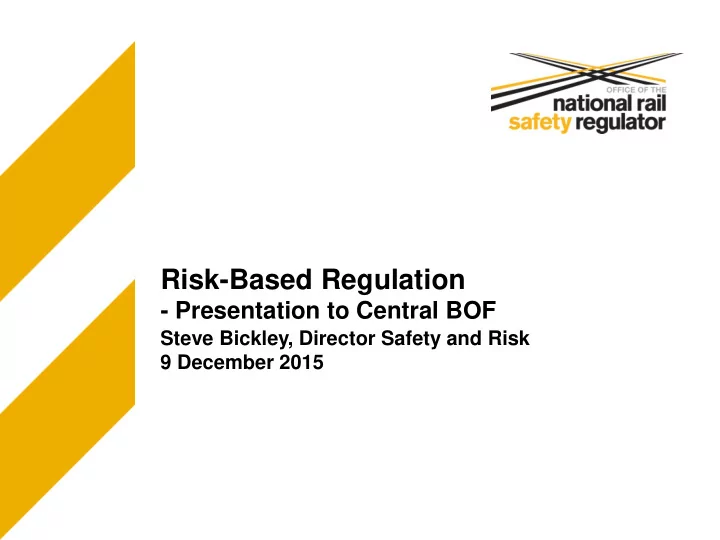

Risk-Based Regulation - Presentation to Central BOF Steve Bickley, Director Safety and Risk 9 December 2015
Contents > Introduction > What is risk-based regulation? > A framework for risk-based regulation > Common elements of regulatory risk frameworks > Benefits of risk-based regulation > Risk Based Regulation in ONRSR Office of the National Rail Safety Regulator 2
Introduction Should a safety regulator focus on: 1. What is illegal? 2. What is harmful? Office of the National Rail Safety Regulator 3
Introduction (2) Prescriptive, rule- Vs. Risk-based based regulator regulator Office of the National Rail Safety Regulator 4
What is risk-based regulation? The application of a systematic framework that prioritises regulatory activities and deployment of regulators’ resources on an evidence -based assessment of risk Baldwin & Black 2007; Black 2010a While regulators have always made regulatory design, implementation and allocation choices, partly to manage limited resource, risk-based regulation formalises and provides consistent structure to the decision making process Sparrow 2000 Office of the National Rail Safety Regulator 5
A Framework for risk-based regulation Regulatory Risk Framework Model (Peterson & Fensling, 2011) > Stage 1, Understanding Risk – Assess and rank > Stage 2, Risk Management – Regulatory design & implementation > Stage 3, Review – Evaluation, feedback, continuous improvement Office of the National Rail Safety Regulator 6
Common elements of regulatory risk frameworks > Defining outcomes > Setting risk appetite > Risk assessment and prioritisation > Regulatory design and implementation Office of the National Rail Safety Regulator 7
Benefits of RBR > Better decision making > More efficient use of resource > Consistency of judgement > More cost-effective regulation > Reduction in the regulatory burden on industry > Enhanced communication of risks & impacts > Improved performance measurement & accountability > Improved public trust of regulatory structures & processes Office of the National Rail Safety Regulator 8
Risk Based Regulation in ONRSR ONRSR Regulatory Approach Key principle – Risk-based regulation Corporate Plan 2015-18, Goal 1 ‘Maintain and improve rail safety through a risk-based approach to regulation ’ ONRSR Regulatory Design & Implementation Office of the National Rail Safety Regulator 9
RBR in ONRSR: Defining outcomes > Align approach with objectives > Improve rail safety for Australian community > Decrease regulatory burden > Provide seamless regulation > Enforce regulatory compliance > Focus on risks, not rules > Risks to the safety of the Australian community arising from rail transport operations Office of the National Rail Safety Regulator 10
RBR in ONRSR: Setting the risk appetite “One of our key functions is to improve rail safety in Australia and we recognise that rail safety risk is an ever-present reality for the rail industry. In respect of rail safety risk, our appetite for risk is driven by the law we administer which compels rail safety duty holders to eliminate or minimize safety risk so far as is reasonably practicable.” Risk Appetite Statement (ONRSR, 2015) Office of the National Rail Safety Regulator 11
RBR in ONRSR: Risk assessment (2/2) Quantitative / qualitative assessment of: > Risk of hazardous events > Risk associated with activities or assets > Risk profile of operators / sectors > Risk associated with non- compliance > Risk associated with proposed change / variation > Risk associated with different areas of legislation Office of the National Rail Safety Regulator 12
RBR in ONRSR: Risk assessment (2/2) Assess and prioritise risks based on a variety of factors: > Occurrence data > Audit / inspection results > Investigation findings > Size of RTO (track km, train km etc) > RTO track record of managing safety risk > Safety performance > Expert judgement Office of the National Rail Safety Regulator 13
RBR in ONRSR: Regulatory design Risk assessment informs regulatory design & implementation decisions: > Which RTOs to audit / inspect, and how often > Areas of focus for compliance activities > Safety improvement projects to progress > How much scrutiny should be applied? > What proportion of total effort do we spend on different regulatory activities (e.g. accreditations vs audit/inspections) Office of the National Rail Safety Regulator 14
Questions?
Recommend
More recommend